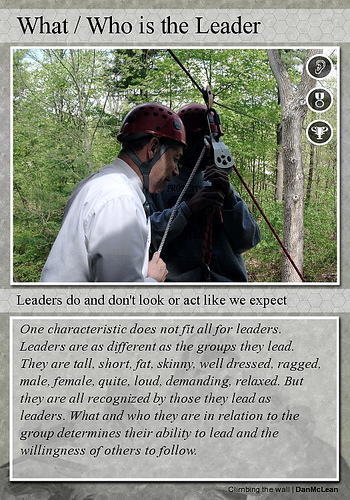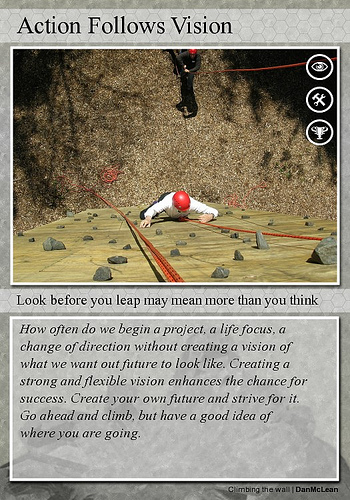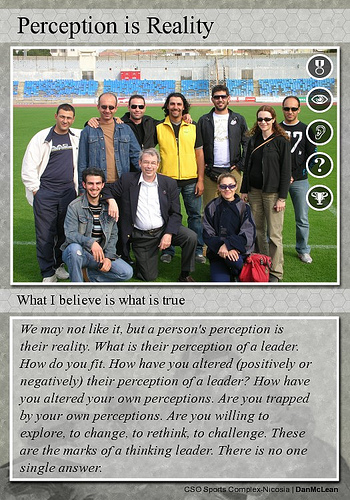Life Skills Development/Unit Two/Leadership/Lesson
Contents
What is leadership?
Leadership can be described as the ability of an individual to influence, motivate, and enable others to contribute toward the effectiveness and success of an organization or group of which they are members. A person who therefore who has this ability is a leader.
What qualities does a leader possess?
Leaders possess a number of common qualities.
- Self-awareness: Knowledge of your own values, passions, skills, strengths and weaknesses, an ability to admit and learn from mistakes and to seek information to fill knowledge gaps.
- Integrity: A strong sense of "what is right" and a demonstration of ethical practices that sets the tone for others. A commitment to teaching by example.
- Courage: The strength to act in accordance with your own values and the greater good despite pressures pushing you in other directions. The ability to put the cause before the desire to be popular.
- Confidence: A belief in your ability to meet most challenges that come your way.
- Vision: A strong sense of where you are going as a person and where you think society, your community and your organization should be going – and how it might get there.
- Enthusiasm: A lively interest in the people, issues and events around you, a feeling of excitement about the possibilities, and the energy to guide them towards fruition.
- Innovation: The ability to "think outside the box;” take risks and develop new and effective solutions to old and emerging problems.
- Wisdom: Intelligence coupled with insight and empathy, as opposed to raw intelligence.
- Adaptability: A willingness to be flexible and to respond quickly and effectively to changing circumstances, along with a commitment to continual learning – formal and informal – and the ability to put that learning into practice.
- Strong inter-personal skills: An ability to interact and work harmoniously with others, while being prepared to take on individual responsibilities.
- Effective communication: A willingness and ability to listen to and understand the thoughts, ideas and concerns of others and to clearly communicate your own. A vision is nothing if it can't be sold to others.
- Belief in others: The desire to build the capabilities of others, praise them where appropriate, go into bat for them when appropriate, provide them with helpful feedback and motivate them to do their best.
- Peer respect: An ability to inspire respect, allowing a person to capably lead discussions, maintain discipline and encourage the contribution of others.
- Insight: The ability to see the big picture, a strong sense the stage attained by followers and intuits problems before they arise or before they become insurmountable.
- Sense of humour: The ability to laugh at yourself and relieve tense or stressful situations with humour
- Competence: Others are unlikely to follow the lead of a person who does not appear to know what s/he is doing.
- Delegation skills: A willingness to trust others and cede some responsibility.
|
QUESTION: Is there a difference between Leadership and Management? ANSWER: The biggest difference between managers and leaders is the way they motivate the people who work or follow them, and this sets the tone for most other aspects of what they do. There are however some people who are both managers and leaders. Managers generally have subordinates while leaders have followers. The table below gives a good idea of the differences between a leader and a manager.
|
|
QUESTION: Are there different leadership styles? ANSWER: There are three (3) classical leadership styles. The Laissez Faire: This largely ‘hands off’ view that tends to minimize the amount of direction and face time. This works well if you have highly trained and highly motivated people around. The Autocratic: This leadership style is more direct and controlling. People tend to be more oriented toward productivity and goals. Their strength is to get things done and make quick decisions. Autocratic leaders take authority and go head first in solving problems. They like freedom to manage themselves and others. They tend to measure their success by the items of tasks/ activities they get done.
|
|
QUESTION: Can leadership be taught? ANSWER: There is the constant debate of whether leaders are born or bred. Some believe that no amount of training can make someone rise to be a leader unless they are born with a ‘leadership gene’. Others take the view that leadership skills can be at least be enhanced, if not developed from scratch, by experience, training, mentoring and circumstance. All it takes is for a person to step forward or step up.
|
|
QUESTION: How can I motivate people? ANSWER: Motivating someone is not that easy. A person can only motivate themselves. A good leader however can create an environment in which this motivation can occur. However deep and complex human nature is all humans share basic needs that must be addressed, ranging from shelter to more sophisticated drives. A hierarchy of needs shows us what we need for motivation.
Physiological Needs: Basic physical needs: the ability to acquire food, shelter, clothing and other basics to survive Safety Needs: A safe and non-threatening work environment, job security, safe equipment and installations Social Needs: Contact and friendship with fellow-workers, social activities and opportunities Ego: Recognition, acknowledgment, rewards Self-Actualization: Realizing one's dreams, using one's gifts, talents and potential. Once basic needs are satisfied, people want more. Progress is the essence of human nature. When people's basic needs are addressed, their mind and soul, free of threat and insecurity, open up to some of their innermost drives. If we discover who every worker is, his/her drives, special gifts, abilities, hopes and plans for the future. If we take time to discover this, understand what makes this person "tick", we will be able to utilize this worker in the position which is the best "fit", a step ahead towards employee motivation.
|


